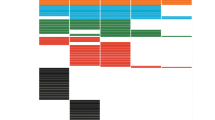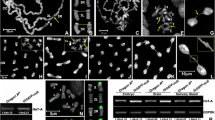Abstract
Bent DNA sites promote the curvature of DNA in both eukaryotic and prokaryotic chromosomes. Here, we investigate the localization and structure of intrinsically bent DNA sites in the extensively characterized Drosophila melanogaster third chromosome DAFC-66D segment (Drosophila amplicon in the follicle cells). This region contains the amplification control element ACE3, which is a replication enhancer that acts in cis to activate the major replication origin ori-β. Through both electrophoretic and in silico analysis, we have identified three major bent DNA sites in DAFC-66D. The bent DNA site (b1) is localized in the ACE3 element, whereas the other two bent DNA sites (b2 and b3) are localized in the ori-β region. Four additional bent DNA sites were identified in the intron of the S18 gene and near the TATA box of the S15, S19, and S16 genes. The identification of DNA bent sites in genomic regions previously characterized as functionally relevant for DNA amplification further supports a function for DNA bent sites in DNA replication in eukaryotes.








Similar content being viewed by others
References
Altman AL, Fanning E (2004) Defined sequence modules and an architectural element cooperate to promote initiation at an ectopic mammalian chromosomal replication origin. Mol Cell Biol 24:4138–4150
Anderson JN (1986) Detection, sequence patterns and function of unusual DNA structures. Nucleic Acids Res 14:8513–8533
Barbosa JF, Bravo JP, Takeda KI, Zanatta DB et al (2008) Intrinsic bent DNA colocalizes with the sequence involved in the Nd-sD mutation in Fibroin light chain gene of the Bombyx mori. BMB Rep 41:394–399
Beall EL, Manak RJ, Zhou S, Bell M, Lipsick JS, Botchan MR (2002) Role for a Drosophila Myb-containing protein complex in site-specific DNA replication. Nature 420:833–837
Biamonti G, Paixão S, Montecucco A, Peverali FA, Riva S, Falaschi A (2003) Is DNA sequence sufficient to specify DNA replication origins in metazoan cells? Chromosome Res 11(5):403–412
Bolshoy A, McNamara P, Harrington RE, Trifonov EN (1991) Curved DNA without A–A: experimental estimation of all 16 DNA wedge angles. Proc Natl Acad Sci USA 88:2312–2316
Calladine CR, Drew HR, Luisi BF, Travers AA (2004) Understanding DNA: the molecule and how it works, 3rd edn. Academic Press, London
Calvi BR, Byrnes BA, Kolpakas AJ (2007) Conservation of epigenetic regulation, ORC binding and developmental timing of DNA replication origins in the genus Drosophila. Genetics 177(3):1291–1301
Claycomb JM, Orr-Weaver TL (2005) Developmental gene amplification: insights into DNA replication and gene expression. Trends Genet 21:149–162
Del Sal G, Manfioletti G, Schneider C (1989) The CTAB-DNA precipitation method: a common mini-scale preparation of template DNA from phagemids, phages or plasmids suitable for sequencing. Biotechniques 7:514–520
Delidakis C, Kafatos FC (1989) Amplification enhancers and replication origins in the autosomal chorion gene cluster of Drosophila. EMBO J 8:891–901
Dibartolomeis SM, Gerbi SA (1989) Molecular characterization of DNA puff II/9A genes in Sciara coprophila. J Mol Biol 210:531–540
Eckdahl TT, Anderson JN (1987) Computer modelling of DNA structures involved in chromosome maintenance. Nucleic Acids Res 15:8531–8545
Fiorini A, Basso LR Jr, Paco-Larson ML, Fernandez MA (2001) Mapping of intrinsic bent DNA sites in the upstream region of DNA puff BhC4-1 amplified gene. J Cell Biochem 83:1–13
Fiorini A, de Gouveia FS, de Soares MA, Stocker AJ et al (2006a) DNA bending in the replication zone of the C3 DNA puff amplicon of Rhynchosciara americana (Diptera: Sciaridae). Mol Biol Rep 33:71–82
Fiorini A, Gouveia FS, Fernandez MA (2006b) Scaffold/matrix attachment regions and intrinsic DNA curvature. Biochemistry 71:481–488
Frydman HM, Cadavid EO, Yokosawa J, Silva FH, Navarro-Cattapan LD, Santelli RV, Jacobs-Lorena M, Graessmann M, Graessmann A, Stocker AJ, Lara FJS (1993) Molecular characterization of the DNA puff C-8 gene of Rhynchosciara ameri cana. J Mol Biol 233:799–803
Gimenes F, Takeda KI, Fiorini A, Gouveia FS, Fernandez MA (2008) Intrinsically bent DNA in replication origins and gene promoters. Genet Mol Res 7(2):549–558
Gouveia FS, Gimenes F, Fiorini A, Fernandez MA (2008) Intrinsic bent DNA sites in the developmentally amplified C3-22 gene promoter of Rhynchosciara americana (Diptera: Sciaridae). Biosci Biotechnol Biochem 72:1190–1198
Iarovaia OV, Bystritskiy A, Ravcheev D, Hancock R, Razin SV (2004) Visualization of individual DNA loops and a map of loop domains in the human dystrophin gene. Nucleic Acids Res 32(7):2079–2086
Kim J, Zwieb C, Wu C, Adhya S (1989) Bending of DNA by gene-regulatory proteins: construction and use of a DNA bending vector. Gene 85:15–23
Krajewski WA, Razin SV (1992) Organization of specific DNA sequence elements in the region of the replication origin and matrix attachment site in the chicken alpha-globin gene domain. Mol Gen Genet 235(2–3):381–388
Lu L, Zhang H, Tower J (2001) Functionally distinct, sequence-specific replicator and origin elements are required for Drosophila chorion gene amplification. Genes Dev 15(2):134–146
Marilley M, Pasero P (1996) Common DNA structural features exhibited by eukaryotic ribosomal gene promoters. Nucleic Acids Res 24:2204–2211
Marilley M, Milani P, Thimonier J, Rocca-Serra J et al (2007) Atomic force microscopy of DNA in solution and DNA modelling show that structural properties specify the eukaryotic replication initiation site. Nucleic Acids Res 35:6832–6845
Milot E, Belmaaza A, Wallenburg JC, Gusew N et al (1992) Chromosomal illegitimate recombination in mammalian cells is associated with intrinsically bent DNA elements. EMBO J 11:5063–5070
Monesi N, Fernandez MA, Fontes AM, Basso-JR LR, Nakanishi Y, Baron B, Buttin G, Paçó-Larson ML (1995) Molecular characterization of an 18 kb segment of DNA puff C4 of B. hygida (Diptera: Sciaridae). Chromosoma 103:715–724
Ohyama T (2005) DNA conformation and transcription. Springer Science + Bussiness Media, New York
Paço-Larson ML, Coelho PSR, Yokosawa J and Lara FJS (2002) Uso de métodos de eletroforese bi-dimensional neutro-alcalina e neutro-neutra para o mapeamento físico de origens de replicação em pufes de DNA. In: Lara FJS (ed) Hibridação de Ácidos Nucléicos. Holos, Editora e Sociedade Brasileira de Genética, Ribeirão Preto, pp 122–133
Palin AH, Critcher R, Fitzgerald DJ, Anderson JN et al (1998) Direct cloning and analysis of DNA sequences from a region of the Chinese hamster genome associated with aphidicolin-sensitive fragility. J Cell Sci 111(Pt 12):1623–1634
Pasero P, Sjakste N, Blettry C, Got C et al (1993) Long-range organization and sequence-directed curvature of Xenopus laevis satellite 1 DNA. Nucleic Acids Res 21:4703–4710
Penalva LOF, Yokosawa J, Stocker AJ, Soares MAM, Graessmann M, Orlando TC, Winter CE, Botella LM, Graessmann A, Lara FJS (1997) Molecular characterization of the C-3 DNA puff gene of Rhynchosciara americana. Gene 193:163–172
Remus D, Beall EL, Botchan MR (2004) DNA topology, not DNA sequence, is a critical determinant for Drosophila ORC-DNA binding. EMBO J 23(4):897–907
Sambrook J, Russell DW (2001) Molecular cloning: a laboratory manual, 3rd edn. Cold Spring Harbor Laboratory Press, New York
Sperbeck SJ, Wistow GJ (1998) pBendBlue: modification of the pBend system for color selectability. Biotechniques 24:66–68
Valle F (1994) PCR-based method to map the bending locus of DNA molecules. PCR Methods Appl 4(1):44–45
Virstedt J, Berge T, Henderson RM, Waring MJ et al (2004) The influence of DNA stiffness upon nucleosome formation. J Struct Biol 148:66–85
Yokosawa J, Soares MA, Dijkwel PA, Stocker AJ, Hamlin JL, Lara FJ (1999) DNA replication during amplification of the C3 puff of Rhynchosciara americana initiates at multiple sites in a 6 kb region. Chromosoma 108(5):291–301
Zhang H, Tower J (2004) Sequence requirements for function of the Drosophila chorion gene locus ACE3 replicator and ori-beta origin elements. Development 131(9):2089–2099
Acknowledgments
We thank Valmir Peron and Marli Licero Schuete Silva for their dedicated technical assistance. FSG received a fellowship from CAPES. This work was supported by grants from CNPq and The Academy of Sciences for the Developing World—TWAS and Universidade Estadual de Maringá facilites (COMCAP laboratories).
Author information
Authors and Affiliations
Corresponding author
Additional information
Communicated by G. Reuter.
Electronic supplementary material
Below is the link to the electronic supplementary material.
438_2009_430_MOESM1_ESM.doc
Supplementary Fig. 1. Location of primers employed in permutation analysis of the615 ori-β 840 bp sequence. The 129 nucleotides before the ori-β sequence are shown in 616 italics. The six pairs of primers that flank the intrinsically bent DNA sites b2 and b3 and 617 that were employed to amplify the 195 bp permuted fragments are shown in color. (DOC 24 kb)
438_2009_430_MOESM2_ESM.tif
Supplementary Fig. 2. 2D projection of the 3D DNA path of the 2348 bp fragment620 containing the ACE3 element, the S18 gene and the ori-β region. The four intrinsically621 bent DNA sites at the 180 (b1), 757 (iS18), 1558 (b2) and 1910 (b3) positions are622 shown. In the figure, rings of different sizes and colors represent the free energy623 variation (ΔG), which predicts the stability of the double helix in the AT rich regions.624 The larger blue rings represent greater ΔG, and the small gray rings represent lower625 values (TIFF 62 kb)
438_2009_430_MOESM3_ESM.pdf
Supplementary Fig. 3. The 600 bp fragments containing the 627 promoter regions of the628 S18, S15, S19 and S16 genes that were employed in the analyses described in Fig. 8 are629 shown. The TATA box region is highlighted in yellow, the ATG in green and the630 intrinsically bent DNA sites in red. The lowercase letters indicate intron sequences. ThedA⋅dT tracts with two or more nucleotides are shown in bold. The CAn631 T motif is632 highlighted in gray. (PDF 16 kb)
Rights and permissions
About this article
Cite this article
Gimenes, F., Assis, M.A., Fiorini, A. et al. Intrinsically bent DNA sites in the Drosophila melanogaster third chromosome amplified domain. Mol Genet Genomics 281, 539–549 (2009). https://doi.org/10.1007/s00438-009-0430-1
Received:
Accepted:
Published:
Issue Date:
DOI: https://doi.org/10.1007/s00438-009-0430-1




